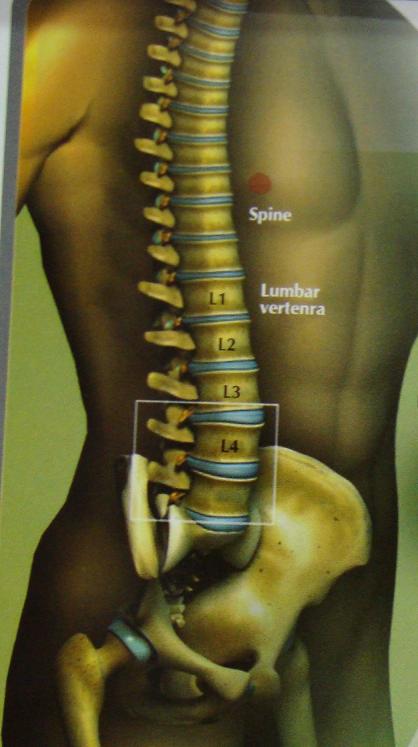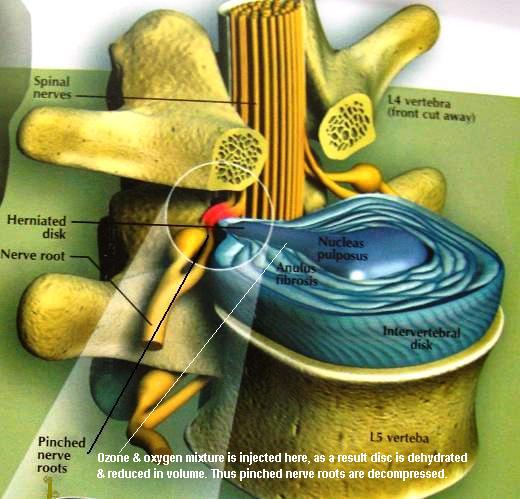Slipped disc
Slipped Disc, Bulging Disc & Back Pain
Are you suffering from slipped disc?
Look for non-operative treatments of slip disc-like ozone discectomy. The total cost of ozone nucleolysis or ozone discectomy is much less than surgical procedures.

What are side-effects of surgery?
Outcome studies of lumber disc surgeries document a success rate between 49% to 95% and re-operation after lumber disc surgeries ranging from 4% to 15%. Reasons for this failure are:
1. Dural fibrosis,
2. Arachnoidal adhesions,
3. Muscle & fascial fibrosis 4. Mechanical instability resulting from the partial removal of bony and ligamentous structures required for surgical exposure and decompression.

What is slipped disc?
When the jell from the disc leaks, it may produce pressure in the spinal cord or nerve roots, causing neck pain or low back pain that goes to the hands or legs. This is known as a herniated disc, prolapsed disc, or slipped disc. Slip disc or slipped disc is one of the most common causes of sciatica.
What happens in slip disc?
The intervertebral discs are cushion-like shock-absorbing pads between the two bones of the spine called vertebrae. These discs are soft gel-filled pads bounded by few layers of membrane called lamella. These discs do not actually “slip,” the disc may rupture. Following this rupture the gel escape into the surrounding tissue. The leaking jelly-like substance (called nucleus pulposus) can produce pressure on the spinal cord or on a single nerve root and cause pain either around the damaged disc or anywhere along the area controlled by that nerve. This condition is also known as a herniated disc, ruptured disc, prolapsed disc, or, more commonly, slip disc or slipped disc.
Where does it hurt? How is the pain?
The most frequently affected area is the low back, but any disc can rupture, including those in the neck. When the discs of low back are ruptured there will be pain in low back that will radiate to the legs. Similarly in case of neck there will be pain in neck that will be radiating to the hands.
The nature of the pain is frequently electric shock-like pain or burning pain. This pain may be associated with some numbness, tingling sensations and sometime some muscle weakness. As there are so many discs in the spine, the exact area of pain depends on the nerve root involved and that again depends on the disc that is involved.
What is sciatica? Is it same as slipped disc?
Sciatica is a frequently used term both by doctors and by patients. It is a symptom and not a disease. Sciatica is defined as any pain that is starting in the low back and is going towards the legs. Sciatica is a non-specific term like fever. Like many diseases may produce fever, many diseases may be the cause of sciatica. Slipped disc is one of the most common causes of sciatica.
What are the treatment?
Since disc prolapse was first diagnosed by Dandy and subsequently by Mixter and Barr it has been implicated as one of the important cause of low back & neck pain radiating to legs & hands. Apart from conservative therapy all other forms of treatment aim at decompressing the nerve roots. These can be done by taking the disc out by surgery or by decompressing the foramen and disc by different interventions. The various treatment options have confused clinicians due to significant failure rate associated with different kinds of surgeries as well as with different interventions.
What are the non-surgical treatments for a slipped disc?
There has been surge of interest in search of safer alternative nonoperative treatment of slipped disc/ slip disc to decompress the nerve roots maintaining the structural stability. Epidural steroid injection, transforaminal epidural decompressions has a high success rate (up to 85%) but chances of recurrences are there specially if these interventions are done at later stage.
Chemonucleolysis using chymopapain has also high success rate (80%) with low recurrences but not popular owing to the chances of anaphylaxis following intradiscal chymopapain injection.
What is Ozone therapy for slipped disc?
Injection of ozone for slipped disc or discogenic radiculopathy (low back pain with radiation to legs) has developed as a nonoperative treatment of slipped disc/ slip disc (or called ozone therapy for slip disc) which is an alternative to chemonucleolysis and disc surgery. Owing to its high success rate, less invasiveness, fewer chances of recurrences and remarkably fewer side effects, ozone therapy for slip disc is becoming popular day by day in the whole world. This is called ozone nucleolysis or ozone discectomy. Percutaneous discectomy is another less invasive nonoperative treatment of slipped disc where disc material is taken out with motorized probe that is introduced through a 17 G needle. Endoscopic discectomy is a minimally invasive surgical procedures where disc material is taken under direct vision.
These nonoperative treatment of slipped disc have revolutionized the treatment of slipped disc/ slip disc. There is quick recovery, less hospital stay, more economical, very little chance of side effects, and no chance of failed back surgery syndrome- the most fearsome complication of open surgery.


